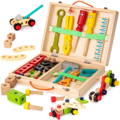Montessori vs. Waldorf: 5 Crucial Differences Every Parent Should Know
The prominent Montessori and Waldorf educational methods have been around since the first half of the 20th century. Yet, they seem more popular these days than ever before. More and more private schools bearing one of these names are opening up across the globe.
The problem parents face nowadays is the clutter of information, making the choice between Waldorf schools and Montessori schools difficult. So, let's pose that big question:
What's the Difference Between Montessori and Waldorf?

Both Montessori and Waldorf schools are schools that follow their own educational model that nurtures child development, focusing on a whole child and not just academic subjects. While the goal of helping children thrive is the same, this healthy development is achieved in different ways.
Here are the five crucial differences between Montessori and Waldorf schools.
1. The Origin of Montessori and Waldorf Schools
The Montessori method was founded and named after Maria Montessori, one of the first Italian female physicians. She was also a teacher - that’s how she perfected her educational method. Moreover, she opened the first Montessori school in Rome in 1907.
The first Casa dei Bambini (Montessori school) was focused on the educational journey of underprivileged children. Later, her Montessori approach to childhood development spread worldwide, with more than 15.000 Montessori schools introducing her methods into early childhood classrooms.

The first Waldorf school was founded in 1919 in Stuttgart. The owner of the Astoria Waldorf cigarette factory invited Rudolf Steiner, an educator, and a spiritualist, to open a school for factory workers’ children.
After that first school, in 1928, the Waldorf school expanded to the United States, New York City specifically. That Waldorf school is still open under the name Rudolf Steiner School. Finally, there are more than 3000 schools around the world that follow the same philosophy.

2. Montessori vs. Waldorf Philosophy
Waldorf education focuses on a child's imagination and imaginative play, and Montessori schools focus on practical life skills. Waldorf schools follow the idea of stories, music, and art being preferred over academic studies in the earliest stages of education. Waldorf method advises schools to introduce core academics to older students.

Maria Montessori firmly believed in children’s “work.” That's how she referred to child’s play. During her teaching years, she discovered that children enjoy learning real-life skills more than make-believe, pretend play.
Consequently, having practical skills gave children more confidence and made them more independent. Some of these skills are:
- preparing meals
- cleaning
- self-care
- gardening
She also included math, spelling, science, and other academic fields into her curriculum through play.
On the other hand, Waldorf education favors fantasy and pretend play until age 7. Also, Rudolf Steiner believed that children’s education is at its best when all its aspects are taught simultaneously - artistic, athletic, academic, and social.
3. Role of the Montessori and Waldorf Teachers
This is probably the biggest difference when comparing Montessori and Waldorf. In most Waldorf schools, classes look like the traditional classes we’re all used to. In a Waldorf classroom, children are seated at their tables, facing the teacher, and listening to their lectures following their academic curriculum. Children learn by being guided by their teacher and following their cues.

However, in the Montessori classroom, things are quite different. Maria Montessori was a big advocate of child-led and hands-on learning experiences. Learning materials are spread out around the classroom, and a child can choose what they’ll learn and when.

The role of the Montessori teacher is to be a guide more than a lecturer. They are there to encourage children to learn important skills in the natural environment at their own pace.
Both Montessori and Waldorf education methods emphasize a child as an individual student. Still, if you choose Montessori, you can expect your child's activities to be designed by your child more than their teacher.
4. Waldorf and Montessori Classroom/Learning Environment
A Montessori preschool learning environment is designed to accommodate the child-led education process. Not only that, but they also have a designated place for every single item and learning material. This is for two reasons:
- children always know where their favorite learning material is and can go and pick it up themselves, encouraging their independence;
- it teaches them responsibility because every item needs to be returned to where it was taken from.

Materials in the Waldorf classroom encourage creative and imaginary play. “Outdoors” are also a big part of Waldorf classrooms. Children learn to use homemade toys and items, and their learning environments can sometimes resemble a fairytale.

Since music, dance, theater, and writing are such a huge part of the Waldorf method, classrooms must be prepared for that. Waldorf classrooms favor nature and arts over technology.
5. Age groups
Montessori classrooms also include mixed-age classrooms. They usually go from 3-6, 6-9, 9-12, etc. Maria Montessori discovered that peers are great teachers - kids pick up a lot by simply playing alongside their friends. This type of play is called parallel play.
However, the age gap inside Montessori classrooms provides an opportunity for various social interactions like learning from older kids or taking leadership.
In this regard, Waldorf classrooms resemble those we all grew up in - all children in one group are the same age. However, they will stay with the same teacher for 5-8 years. This is longer than is the case with the Montessori philosophy of education.
What Are the Disadvantages of the Waldorf Curriculum?
Some of the flaws that numerous parents have pointed out in connection with the Waldorf educational method are these:
- There is no standardized testing.
- Academic studies, even reading, are delayed until age 7.
- Fields of study are quite different from those found in other schools.
- Parents must keep their children away from any type of modern technology (TV, video games, phones, tablets) as much as possible.
- Many stories that are part of the core Waldorf education rely on the Bible, which some people might find unsuitable for their children.
- Parents are expected to educate themselves all the time and read lots of materials provided by Waldorf schools.
What Type of Child Thrives in Montessori?
Montessori education can be good for a variety of personalities. For example, if your child lacks confidence and waits for you to come up with activities and entertainment, they could benefit from a Montessori individualistic approach that encourages independence.
Also, children bursting with energy, whose focus isn’t their strong suit, might find some sense of order in Montessori environments.
The main idea of the Montessori method and philosophy is that it should be available to and accommodate every child. It focuses on one-on-one teaching and guiding, letting a child take the lead in their education.
Almost any child can thrive in this situation - all they need is a little support. However, families that put too much pressure on their children to become high achievers might find that many Montessori schools aren't goal-focused enough.
Can You Blend Waldorf and Montessori?
You can combine some aspects of these two methods, but not all. One method focuses on practical skills, and the other on an imaginary play. Take Montessori DIY Chair, for example.
This DIY toy is a great way to practice problem-solving skills on an everyday item, such as a chair. On the other hand, it is possible to rearrange the elements in many different ways.

Both of these education methods focus on a child as an individual. Both of them base their approach on the whole child and their personality - mind, body, and emotions. Ultimately, you know your child the best.
What do they like best? What are their interests? In what kinds of situations do they thrive the most?
Once you answer those questions, you can look for more information that works best with your child’s likings and habits. Another thing to consider is whether you’re ready to commit to one or the other method. Both ask for a specific change in your everyday life.
Final Verdict: Which Is Better, Montessori or Waldorf?
Both Montessori and Waldorf philosophies in education result in excellent, well-rounded educational experiences for their students. The right choice depends on every student's individual preferences and learning styles.
To simplify things to the extreme, we can speculate that a Montessori student is a more self-sufficient person thriving in practical life skills. Waldorf students may need more structured guidance while having the freedom to express their creativity.
Giving a straight-out answer is not an easy task. We all have our own experiences and opinions that come from them.
The fact is, the Montessori method is much more popular around the world. There are tens of thousands more Montessori schools than Waldorf schools.
Also, plenty of online Montessori toy stores can be a great introduction to Montessori education. You can even try some right now by simply browsing these Montessori toys by age.
Whether you choose a Waldorf school or a Montessori School, learn as much as possible about it. Montessori and Waldorf schools are not conventional, and some of their aspects might initially look odd to you.
However, once you educate yourself about them, you won’t find it strange when you see a classroom full of children doing “whatever” they please yet learning so much at the same time.
Free Delivery
Over $80
Easy Returns
No questions asked
Unbeatable Warranty
1-year ++ warranty
- Secure CheckoutWorld’s most secure payment method
















